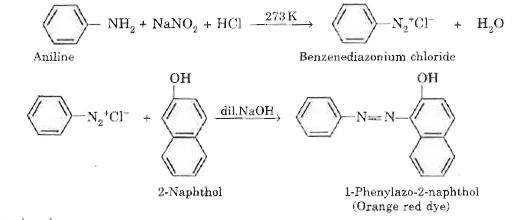Give one chemical test to distinguish between the following pairs of compounds .
i. Methylamine and dimethylamine
ii. Secondary and tertiary amines
iii. Ethylamine and aniline
iv. Aniline and benzylamine
v. Aniline and N-methylaniline
(i) These can be distinguished by carbylamine test. When heated with alcoholic solution of KOH and chloroform, methyl- amine gives foul smell of methyl isocyanide.
CH3NH2Methylamine+CHCl3+3KOHalc.→CH3NCMethyl isocyanidefoul smell+3KCl+3H2O
Dimethylamine does not give this test.
(CH3)2NHDimethlamineCHCl3,KOH−−−−−−−→Δ No reaction
(ii) Secondary amines give Libermann nitrosoamine test while 3∘ amines do not. 2∘ amine on treatment with HNO2 (prepared in situ by the action of HCl on NaNO2) gives yellow coloured oily N-nitrosoamine.
(CH3CH2)2NHDiethylamine+HO−N=O→CH3CH2N-Nitrosodiethylamine(Yellow colour)2N−N=O+H2O
N-Nitrosodiethylamine on warming with a crystal of phenol and conc. H2SO4 gives a green solution which when made alkaline with aqueous NaOH turns deep blue and then red on dilution. Tertiary amines donot give this test.
(iii) These can be distinguished by azo dye test.
Dissolve the compound in conc. HCl and add ice-cold solution of HNO2(NaNO2+dilHCI) and then treat it with an alkaline solution of 2-naphthol. Appearance of brilliant orange or red dye indicates aniline.

Ethylamine does not form dye. It will give brisk effervescence due to the evolution of N2 but solution remains clear.
(iv) These can be distinguished by azo dye test.
Aniline reacts with HNO2 ( NaNO2 + dil. HCI) at 273-278K to form stable benzene diazonium chloride which on treat ment with an alkaline solution of 2-naphthol gives an orange dye (as given in reaction (iii)).
Benzylamine does not give azo dye test.
(v) These can be distinguished by carbylamine test. Aniline being primary amines gives carbylamine test i.e., when heated with an alcoholic solution of KOH and CHCl3 ,it gives foul smell of phenyl isocyanide.
C6H5NH2+CHCl3+3KOH(alc.)Δ−−→C6H5NCPhenylisocyanide+3KCl+3h2OAniline
C6H5NH–CH3N-MethylanilineCHCl3,KOH−−−−−−−−−−→Δ No reaction
Topper's Solved these Questions
- BOOK - MODERN PUBLICATIONCHAPTER - ORGANIC COMPOUNDS CONTAINING NITROGEN EXERCISE - NCERT FILE NCERT (EXEMPLAR PROBLEMS) (MULTIPLE CHOICE QUESTION (TYPE -I))27videos
ORGANIC COMPOUNDS CONTAINING NITROGEN
- BOOK - MODERN PUBLICATIONCHAPTER - ORGANIC COMPOUNDS CONTAINING NITROGEN EXERCISE - NCERT FILE MULTIPLE CHOICE QUESTION (TYPE -II)10videos
ORGANIC COMPOUNDS CONTAINING NITROGEN
- BOOK - MODERN PUBLICATIONCHAPTER - ORGANIC COMPOUNDS CONTAINING NITROGEN EXERCISE - NCERT FILE (NCERT IN-TEXT QUESTIONS)9videos
ORGANIC COMPOUNDS CONTAINING NITROGEN
- BOOK - MODERN PUBLICATIONCHAPTER - HALOALKANES AND HALOARENESEXERCISE - UNIT PRACTICE TEST11videos
HALOALKANES AND HALOARENES
- BOOK - MODERN PUBLICATIONCHAPTER - POLYMERSEXERCISE - Competition file (OBJECTIVE TYPE QUESTIONS) (C. MULTIPLE CHOICE QUESTIONS)(Integer Type Questions)6videos
POLYMERS
Similar Questions
Give one chemical test to distinguish between the following pairs of compounds :
Methylamine and dimethylamineView SolutionGive the chemical tests to distinguish between the following pairs of compounds :
Methylamine and dimethylamineView SolutionGive one chemical test to distinguish between the following pairs of compounds .
i. Methylamine and dimethylamine
ii. Secondary and tertiary amines
iii. Ethylamine and aniline
iv. Aniline and benzylamine
v. Aniline and N-methylanilineView SolutionGive one chemical test to distinguish between the following pairs of compounds :
Ethylamine and anilineView SolutionGive one chemical test to distinguish between the following pairs of compounds :
Aniline and N-methylanilineView SolutionGive one chemical test to distinguish between the following pairs of compounds :
Aniline and benzylamineView SolutionGive one chemical test to distinguish between the following pairs of compounds:
(i) Methylamine and dimethylamine
(ii) Aniline and benzylamineView SolutionGive the chemical tests to distinguish between the following pairs of compounds :
Aniline and N-methylanilineView SolutionGiven the chemical tests to distinguish between the following pairs of compounds :
(i) Methylamine and Dimethylamine
(ii) Aniline and N - MethylamineView SolutionGive one chemical test to distinguish between the following pairs of compounds :
Secondary and tertiary aminesView Solution

